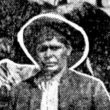Loading map...

Aboriginal trackers worked at Silverton police station from January 1884 until October 1890. They were initially based in a small timber and iron structure that also served as the gaol. The more substantial police station and gaol shown in the photograph were completed in 1889, only one year before the last tracker departed Silverton. The gaol itself was only used until 1892, by which time the Silverton population was in decline. The police station and gaol are now the local museum.[ref]See Police Salary Registers, 1884-1890; Silverton by R.H.B. Kearns, published by the Broken Hill Historical Society, 1972.[/ref]
The town was surveyed in 1883 and the population initially boomed thanks to the discovery of nearby lodes of silver ore, reaching a peak of 3,000 in the mid-1880s. Unsurprisingly, trackers were sometimes asked to investigate thefts of ore. In August 1886, Tracker Frank pursued a dray packed with over 150kg of stolen silver. The wheel ruts led Frank to the Umberumberka Hotel several kilometres west of Silverton where a suspect known as “Bat-hole Bob” was arrested.[ref]Maitland Mercury and Hunter River General Advertiser 10 August 1886: 5.[/ref]
Little is known about the other trackers who worked at Silverton, including Tommy, Jim (or Jemmy) Kane, Harry Bale, Harry Edwards and Harry McDonald. Jim Kane was a well-travelled tracker, having previously worked at Jindabyne and Darlington Point. Harry McDonald, the last tracker to work at Silverton from April to October 1890, may have been married in a traditional ceremony to an Aboriginal woman from Yallock (in Ngiyampaa country) called Nellie Policeman. Nellie passed away at Roto in 1903.[ref]Death Certificate of Nellie Policeman 1903/013299; Death Certificate of Albert McDonald 1939/013299[/ref]

 This website explores the history of Aboriginal trackers in NSW from 1862 when the current NSW Police Force was established through to 1973 when the last tracker, Norman Walford, retired. You can read about the lives of individual trackers and some of the incredible tracking feats they...
This website explores the history of Aboriginal trackers in NSW from 1862 when the current NSW Police Force was established through to 1973 when the last tracker, Norman Walford, retired. You can read about the lives of individual trackers and some of the incredible tracking feats they...

There were over 200 NSW police stations that employed Aboriginal trackers between 1862 and 1973. Many were concentrated in the central-west and north-west of the state, the agricultural and pastoral heartland of NSW. This is because one of the main jobs of trackers was to pursue sheep, cattle and horse thieves. Trackers sometimes lived in small huts out the back...
Learn More ►
Pathfinders book Pathfinders, A history of Aboriginal trackers in NSW, written by Dr Michael Bennett and published by NewSouth, is now available from all good bookstores. Click on the link below to order your copy. https://www.abbeys.com.au/book/pathfinders-a-history-of-aboriginal-trackers-in-nsw.do Early History Since the beginning of the colony, government agencies, explorers, surveyors and members of the general public called upon the tracking...
Learn More ►